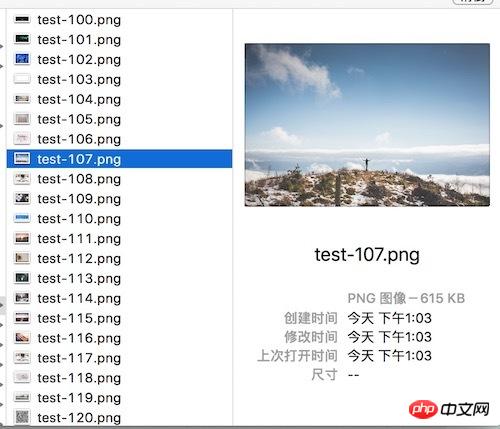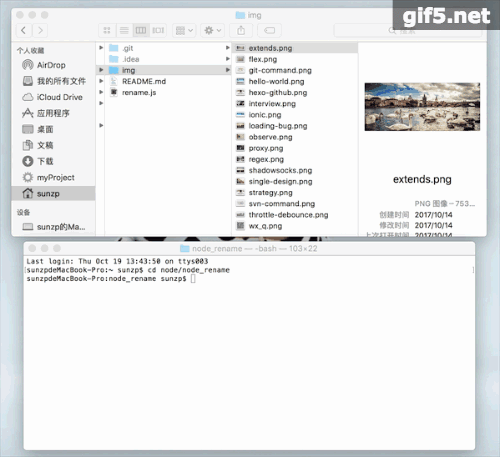Detailed explanation of node file batch renaming examples
This article mainly introduces the example of the method of batch renaming node files. The editor thinks it is quite good, so I will share it with you now and give it as a reference. Let’s follow the editor to take a look, I hope it can help everyone.
In an actual requirement, a batch of files (such as text, pictures) need to be renamed and numbered according to numbers. I just took this opportunity to get familiar with node's fs file operations and wrote a script to batch modify file names.
Requirements
The following image files currently exist

The file names need to be modified in batches , become a unified prefix name and automatically increase the index. The effect after modification is

The simplest manual operation is to rename files one by one, but in the spirit of DRY(Don' t repeat yourself) principle, it is better to write a node script.
Research
To perform file operations in node, you need to understand the fs module
There are synchronous and asynchronous in the fs module Two ways
Read files
//异步
fs.readFile('test.txt', 'utf-8' (err, data) => {
if (err) {
throw err;
}
console.log(data);
});
//同步
let data = fs.readFileSync('test.txt');
console.log(data);Asynchronously read file parameters: file path, encoding method, callback function
Write file
fs.writeFile('test2.txt', 'this is text', { 'flag': 'w' }, err => {
if (err) {
throw err;
}
console.log('saved');
});Write file parameters: target file, write content, write form, callback function
flag writing method:
r: read file
w: write file
a: append
Create directory
fs.mkdir('dir', (err) => {
if (err) {
throw err;
}
console.log('make dir success');
});dir is the name of the new directory
Read the directory
fs.readdir('dir',(err, files) => {
if (err) {
throw err;
}
console.log(files);
});dir is the directory name to read, files is the file or directory name array under the directory
Get file information
fs.stat('test.txt', (err, stats)=> {
console.log(stats.isFile()); //true
})Stats method after obtaining file information:
| Method | Description |
|---|---|
| stats.isFile() | Whether it is a file |
| stats.isDirectory() | Whether it is a directory |
| stats.isBlockDevice() | Whether it is a block device |
| stats.isCharacterDevice() | Whether it is a character device |
| stats.isSymbolicLink() | Whether it is a soft link |
| stats.isFIFO() | Whether it is a UNIX FIFO command pipeline |
| stats.isSocket() | Whether to create a read stream for Socket |
let stream = fs.createReadStream('test.txt');
let stream = fs.createWriteStreamr('test_copy.txt');
Development
- Read the source directory
- Determine whether the storage directory exists, and create a new directory if it does not exist
- Copy files
- Determine whether the copied content is a file
- Create a read stream
- Create a write stream
- Link pipe, write file content
let fs = require('fs'),
src = 'src',
dist = 'dist',
args = process.argv.slice(2),
filename = 'image',
index = 0;
//show help
if (args.length === 0 || args[0].match('--help')) {
console.log('--help\n \t-src 文件源\n \t-dist 文件目标\n \t-n 文件名\n \t-i 文件名索引\n');
return false;
}
args.forEach((item, i) => {
if (item.match('-src')) {
src = args[i + 1];
} else if (item.match('-dist')) {
dist = args[i + 1];
} else if (item.match('-n')) {
filename = args[i + 1];
} else if (item.match('-i')) {
index = args[i + 1];
}
});
fs.readdir(src, (err, files) => {
if (err) {
console.log(err);
} else {
fs.exists(dist, exist => {
if (exist) {
copyFile(files, src, dist, filename, index);
} else {
fs.mkdir(dist, () => {
copyFile(files, src, dist, filename, index);
})
}
});
}
});
function copyFile(files, src, dist, filename, index) {
files.forEach(n => {
let readStream,
writeStream,
arr = n.split('.'),
oldPath = src + '/' + n,
newPath = dist + '/' + filename + index + '.' + arr[arr.length - 1];
fs.stat(oldPath, (err, stats) => {
if (err) {
console.log(err);
} else if (stats.isFile()) {
readStream = fs.createReadStream(oldPath);
writeStream = fs.createWriteStream(newPath);
readStream.pipe(writeStream);
}
});
index++;
})
}
How to use node to implement a function to batch rename files
PHP batch rename a certain Introduction to the implementation method of all files in the folder
The above is the detailed content of Detailed explanation of node file batch renaming examples. For more information, please follow other related articles on the PHP Chinese website!

Hot AI Tools

Undresser.AI Undress
AI-powered app for creating realistic nude photos

AI Clothes Remover
Online AI tool for removing clothes from photos.

Undress AI Tool
Undress images for free

Clothoff.io
AI clothes remover

AI Hentai Generator
Generate AI Hentai for free.

Hot Article

Hot Tools

Notepad++7.3.1
Easy-to-use and free code editor

SublimeText3 Chinese version
Chinese version, very easy to use

Zend Studio 13.0.1
Powerful PHP integrated development environment

Dreamweaver CS6
Visual web development tools

SublimeText3 Mac version
God-level code editing software (SublimeText3)

Hot Topics
 1386
1386
 52
52
 The driver cannot load ene.sys on this device in Windows 11
May 05, 2023 am 09:13 AM
The driver cannot load ene.sys on this device in Windows 11
May 05, 2023 am 09:13 AM
Many Windows 11 users have encountered the error message “The driver could not be loaded on this device (ene.sys)” which prevents the driver from loading on the system and is marked as vulnerable. However, this issue is mainly reported by users who have upgraded their PC to Windows 11. This error is closely related to drivers and files that get corrupted due to system operating system update issues. If you are encountering this “ene.sys” error every time you turn on your Windows 11 computer after an update, continue reading this article. Here you will find some troubleshooting methods that you can use if you see this error on your PC. Fix 1 – Install Optional Update Step 1. Use Windows+R group
 4 Ways to Quickly Rename a Printer on Windows 11
Sep 11, 2023 pm 03:26 PM
4 Ways to Quickly Rename a Printer on Windows 11
Sep 11, 2023 pm 03:26 PM
If you have a lot of printers in your office, the printer list can be long and make getting work done tedious. What's more, multiple printers usually mean similar names, which can be a bit confusing. The last thing you want is to scroll through an endless list and still end up sending your print job to the wrong printer. Fortunately, you can solve all of these problems with a simple renaming trick, which we'll show you below. How do I rename my printer in Windows 11? 1. Using the Settings app tap the key and click Settings. Windows click Bluetooth and Devices and select Printers and Scanners. Select the printer you want to rename. Click Printer Properties. Navigate to the General tab, key
![Explorer.exe does not start on system startup [Fix]](https://img.php.cn/upload/article/000/887/227/168575230155539.png?x-oss-process=image/resize,m_fill,h_207,w_330) Explorer.exe does not start on system startup [Fix]
Jun 03, 2023 am 08:31 AM
Explorer.exe does not start on system startup [Fix]
Jun 03, 2023 am 08:31 AM
Nowadays, many Windows users start encountering severe Windows system problems. The problem is that Explorer.exe cannot start after the system is loaded, and users cannot open files or folders. Although, Windows users can open Windows Explorer manually using Command Prompt in some cases and this must be done every time the system restarts or after system startup. This can be problematic and is due to the following factors mentioned below. Corrupted system files. Enable fast startup settings. Outdated or problematic display drivers. Changes were made to some services in the system. Modified registry file. Keeping all the above factors in mind, we have come up with some that will surely help the users
 SVM examples in Python
Jun 11, 2023 pm 08:42 PM
SVM examples in Python
Jun 11, 2023 pm 08:42 PM
Support Vector Machine (SVM) in Python is a powerful supervised learning algorithm that can be used to solve classification and regression problems. SVM performs well when dealing with high-dimensional data and non-linear problems, and is widely used in data mining, image classification, text classification, bioinformatics and other fields. In this article, we will introduce an example of using SVM for classification in Python. We will use the SVM model from the scikit-learn library
 How to batch rename file suffixes in win10
Jul 06, 2023 pm 07:37 PM
How to batch rename file suffixes in win10
Jul 06, 2023 pm 07:37 PM
How to batch rename file suffixes in win10? Nowadays, many users are using the Win10 system, and when we usually use computers, we often use a lot of shortcut keys, because shortcut keys can make our operations more convenient, so how do we rename files in batches? Below, the editor will introduce to you the operation of batch renaming files in Win10. How to batch rename files in Win10 1. Select all the files you want to rename. 2. Right-click on a selected file and select Rename. 3. After a file is renamed, other files will be marked with serial numbers in turn. The method is very simple, but when modifying, you need to pay attention to the order of the files and the sorting position of the modified sample files. The serial number starts from the modified sample file.
 CS:GO crashes, freezes and black screen issues in Windows 10/11
Apr 30, 2023 pm 06:40 PM
CS:GO crashes, freezes and black screen issues in Windows 10/11
Apr 30, 2023 pm 06:40 PM
Just like any other game on your PC, Counter-Strike: Global Offensive can crash, freeze, or get stuck in a black screen on launch. Counter-Strike is one of the low resource fps games on the market and it even runs on Tudou PC. Although CSGO is a CPU-oriented game, the system GPU also plays an important role. The black screen issue is related to GPU issues. Follow these simple solutions to solve the problem. Fix 1 – Turn off compatibility If you are running the game in compatibility mode on Windows 8 or 7, turn it off. CSGO works with every version of Windows (WindowsXP or higher)
 What is the shortcut key for renaming? What is the shortcut key for renaming?
Feb 22, 2024 pm 02:50 PM
What is the shortcut key for renaming? What is the shortcut key for renaming?
Feb 22, 2024 pm 02:50 PM
The shortcut key for renaming is F2. Analysis 1 The shortcut key for renaming is F2. 2 If you want to rename a file or folder, you can press F2 after selecting the file, modify it directly and press Enter. 3 Sometimes you can also use the mouse to select the file, right-click, select Rename, and press Enter after the modification is completed. 4 Shortcut keys refer to the special combination or sequence of keys on the keyboard to quickly complete a certain command, which can effectively improve work efficiency. Supplement: What are shortcut keys? 1 Shortcut keys, also called hot keys, refer to completing an operation through certain specific keys, key sequences or key combinations. You can use shortcut keys to do some work instead of the mouse. You can use keyboard shortcuts to open, close, and navigate the start menu, desktop, menus, and dialog boxes.
 How to change file type on Windows 11/10
Oct 27, 2023 pm 02:13 PM
How to change file type on Windows 11/10
Oct 27, 2023 pm 02:13 PM
Changing the file type (extension) is a simple task. However, sometimes simpler things can get tricky, and changing file extensions is one of them. Extreme care should be taken when changing file types, as a simple mistake can brick the file and render it inoperable. So, we discussed various ways to change file types on Windows 11, 10. How to Change File Type on Windows 11, 10 There are two ways to do this. You can use the direct GUI method (in File Explorer) or you can change the file type from the terminal. Way 1 – Using File Explorer Way 2 – Using CMD Terminal Way 1 – Changing the file type directly You can directly change the file type from up and down in File Explorer




